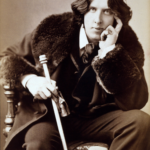By Khadija Rida
The Picture of Dorian Gray is a meditation on morality and aestheticism now considered a masterpiece of late 19th century English literature. It is also the only novel ever written by Oscar Wilde.

Oscar Wilde (1854–1900) was a famous Irish author, playwright, and poet. Wilde was known for many provocative works including ‘The Picture of Dorian Gray’ and ‘The Importance of Being Earnest,’ as well as his brilliant wit and flamboyant personal style. He is also known for his infamous imprisonment for homosexuality, after a trial in which this book was used as evidence against him in court.
The Picture of Dorian Gray is a splendid example of late-Victorian Gothic fiction with its exploration of the dark desires and forbidden pleasures that challenge otherwise respectable characters. The novel also captures the relationship between art and reality by emphasizing the troubled interaction between ethics and aesthetics when dealing with the themes of beauty, youth, and sin. It also deals with the historically controversial theme of homosexuality.
In the beginning of this book, Wilde prefaces The Picture of Dorian Gray, with a reflection on art, the artist, and the utility of both. He concludes that “All art is quite useless.” With this sentence, Wilde summarizes all the principles of the Aesthetic Movement then popular in Victorian England. Simply put, real art takes no part in building the social or moral codes of society and it never should. Art should be beautiful and pleasure its observers, but not be idolized.
The story then starts with Basil Hallward, a famous artist who is painting the portrait of his friend and muse Dorian Gray, a young, charismatic, and handsome aristocrat. He is impressed and infatuated with Dorian’s beauty, believing that this beauty is responsible for his artistic imagination. However, even though the portrait is breathtaking, with many fawning over it, Basil does not want it to be set on display for any reason.
Dorian meets Lord Henry, and is enthralled and tempted by the aristocrat’s hedonistic view of the world, which celebrates youth, beauty, and the selfish pursuit of pleasure. He then secretly offers to sell his soul if only his portrait could magically bear the burden and consequences of age, and bad behavior rather than himself. Little does he know that this wish has sealed his fate.
As the years pass, Dorian continues to follow a libertine life of various immoral activities while staying young and beautiful. Meanwhile, his portrait records every sin, and shows who Dorian Gray truly becomes.
Overall, the meaning can be considered a modern version of the Renaissance myth of Dr. Faustus. Faustus sold his soul to the Devil to have his desire for knowledge satisfied. Just like him, Dorian also sells his soul to the devil to satisfy his desires. In the novel, the picture is the hidden mirror of Dorian, recording all his actions and mistakes on his painted image, thereby revealing the true state of his body and soul. Dorian’s story teaches us the dangers of desiring eternal youth. We shouldn’t desire such a thing. We should embrace all the various stages of life, learning from the pros, and cons of each.
